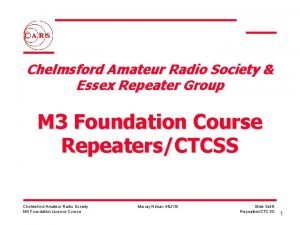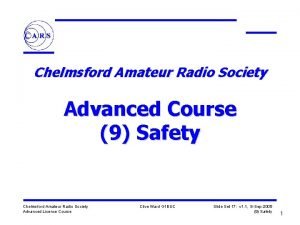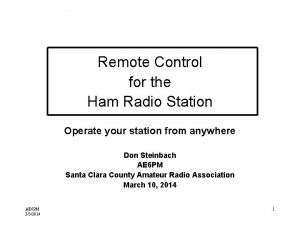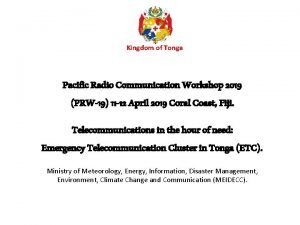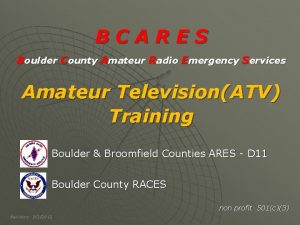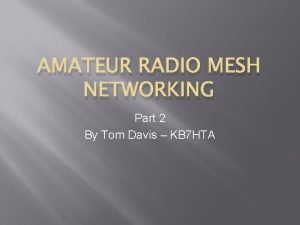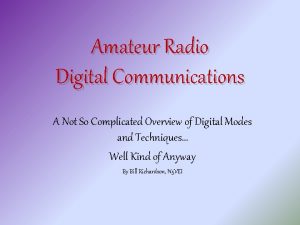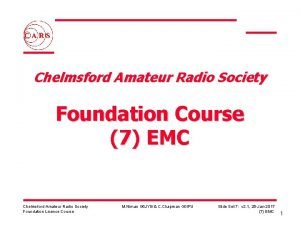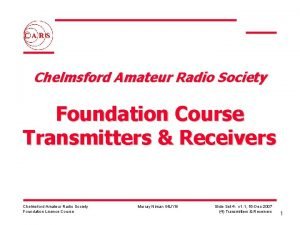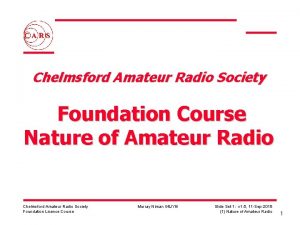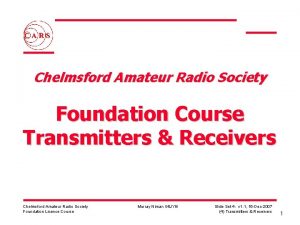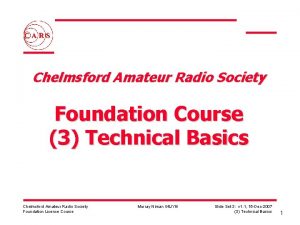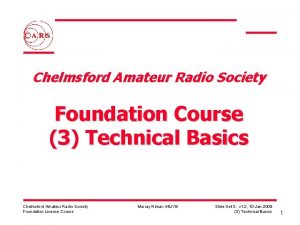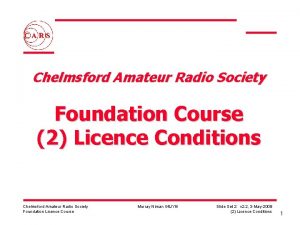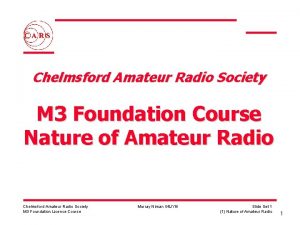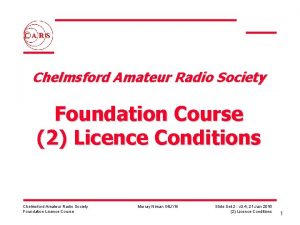Chelmsford Amateur Radio Society Foundation Course Safety Chelmsford











- Slides: 11

Chelmsford Amateur Radio Society Foundation Course Safety © Chelmsford Amateur Radio Society Foundation Licence Course Murray Niman G 6 JYB Slide Set 9: v 2. 0, 12 -Jan-2020 Safety 1

Safety Philosophy • At Foundation level, the emphasis is on avoidance of risk, not the skills for working on live equipment. • Foundation Licensees need to have an appreciation of – The Dangers of High Voltages – The risk of Electrocution – Risk of RF Induction Heating on Metal Rings, Watches – Potential of RF Burns – Hearing Damage from excessive Headphone Use © Chelmsford Amateur Radio Society Foundation Licence Course Murray Niman G 6 JYB Slide Set 9: v 2. 0, 12 -Jan-2020 Safety 2

Electrical Wiring • Items ought to be earthed, and Radio Shacks protected by a Residual Current Breaker with Overcurrent (RCBO) • These trip when there is a residual Live/Neutral imbalance of ~30 m. A, as well as protecting from overloads/shorts • Only items which have ‘Double Insulation’ need not be earthed • Have a single well marked Master ‘OFF’ switch for shack power • If you are a rescuer, do not touch a casualty unless you are sure power is off, else you will become a casualty yourself © Chelmsford Amateur Radio Society Foundation Licence Course Murray Niman G 6 JYB Slide Set 9: v 2. 0, 12 -Jan-2020 Safety 3

Safety Earthing • Ensure shack equipment is run from a common mains earth to prevent earth loops - use filtered mains boards and ferrite rings correctly • Beware that modern plastic Gas & Water Pipes give high resistance and are unsuitable for earths • Beware of some House earths floating above earth potential • Do not mix: – Mains Earth (for Safety) with. . . – RF Earths (for Antennas) • In any case mains earths are electrically noisy © Chelmsford Amateur Radio Society Foundation Licence Course Murray Niman G 6 JYB Slide Set 9: v 2. 0, 12 -Jan-2020 Safety 4

Protective Multiple Earthing • Be aware that modern electrical house wiring may employ Protective Multiple Earthing - PME • It is extremely important to check if this applies your situation • Special care is needed on earthing arrangements to avoid risks in PME fault situations - an RSGB PME Leaflet is available • Details can be sought from the electrical supply company - seek specialist/qualified advice! © Chelmsford Amateur Radio Society Foundation Licence Course Murray Niman G 6 JYB Slide Set 9: v 2. 0, 12 -Jan-2020 Safety 5

Batteries • Batteries are a prominent feature of amateur radio equipment • The variety includes Lead-Acid Car Batteries, Lithium and other chemistries • Different battery technologies require different charging techniques. Make sure you use the correct type of charger and follow the manufacturers instructions – do not assume without checking! • Some batteries can supply very high currents which can be hazardous if subjected to short circuit • Lithium batteries in particular can cause fire and explosion if not properly treated © Chelmsford Amateur Radio Society Foundation Licence Course Murray Niman G 6 JYB Slide Set 9: v 2. 0, 12 -Jan-2020 Safety 6

Mains Plugs • At Foundation It is important to recognise a safely wired mains plug • Flex: Each wire must securely connect to the correct pin, without fraying/whiskers: – Live=Brown, – Neutral=Blue, – Earth=Green/Yellow • The flex must be in good condition and held captive by the cord grip. Insulation must not be damaged etc • Fuses: They need to protect the equipment. Low power devices must be correctly fused at 3 A or 5 A - not always 13 Amps • Fuses are thin wires designed to melt. If one blows, check why! • Faults aren’t always shorts. A fault may not blow a large fuse, but may overheat a flex and cause overheating/fire © Chelmsford Amateur Radio Society Foundation Licence Course Murray Niman G 6 JYB Slide Set 9: v 2. 0, 12 -Jan-2020 Safety 7

RF Safety • Exposure: RF essentially heats body tissue, of which the eyes are the most vulnerable. Foundation powers are low, but it is still advisable to apply common sense • Guidance: Suitable limits are set by Government and Standards bodies such as Public Health England ICNIRP • Antennas: Exposed RF conductors / elements should not be touched when transmitting and should be mounted to avoid accidental contact • Microwaves: At 10 GHz, waveguide tubing may be used if coax is unsuitable – don’t look down it if the RF is on! © Chelmsford Amateur Radio Society Foundation Licence Course Murray Niman G 6 JYB Slide Set 9: v 2. 0, 12 -Jan-2020 Safety 8

Indoors • Shack Tidiness: Avoid trailing mains leads on the shack floor - Trip Hazards! • Headphones: Be aware that excessive use to pick out weak signals from background noise can damage hearing • Power Supplies: Allow time for PSUs to fully discharge after switching off • Tools: Handle with care and use eye protection • Soldering: Use a stand, avoid flux fumes and don’t get burnt! • Lightning: Disconnect your Antennas! - protect your radios from static charges © Chelmsford Amateur Radio Society Foundation Licence Course Murray Niman G 6 JYB Slide Set 9: v 2. 0, 12 -Jan-2020 Safety 9

Ladders - Safety • Antenna erection is potentially hazardous. Take care when using ladders and seek help • The correct angle for ladders can be expressed as a 4: 1 height-to-base ratio 4 Metres • Ladders should be suitably secured at the top or held at the bottom by an adult • Over-reaching can cause a fall or cause the ladder to slip, rotate • Use a tool belt to carry tools as this will help prevent falling objects • Wear hard hats when working at height, or when others are working at height © Chelmsford Amateur Radio Society Foundation Licence Course Murray Niman G 6 JYB 1 Metre Slide Set 9: v 2. 0, 12 -Jan-2020 Safety 10

Outdoors • Lightning: High antennas may need special protection / advice • Feeders/Antennas: All should be soundly fixed in case of being accidentally being pulled, high winds, icing, bird strikes • Portable/Mobile Operating: – Ensure antennas and guy ropes are securely fastened – Avoid hazards from trailing wires, damp conditions, frayed insulation, temporary mains connections etc – Keep antennas clear of Overhead Power lines, and snagging or coupling in to telephone lines • Safety is everybody's responsibility – in the shack and outside © Chelmsford Amateur Radio Society Foundation Licence Course Murray Niman G 6 JYB Slide Set 9: v 2. 0, 12 -Jan-2020 Safety 11
